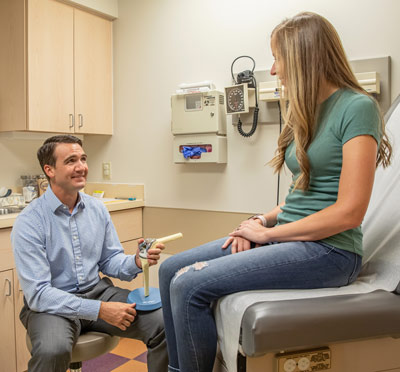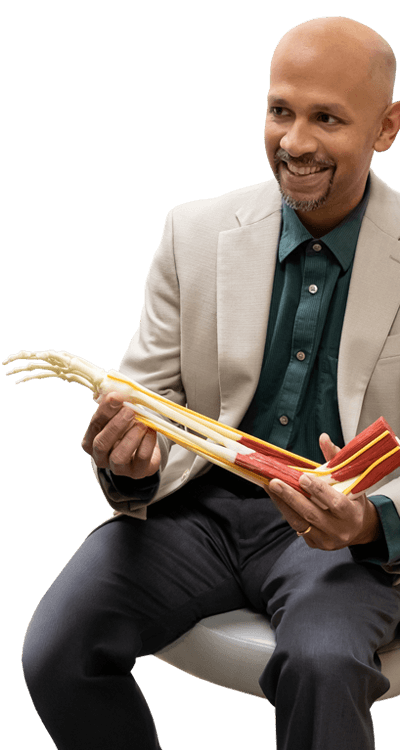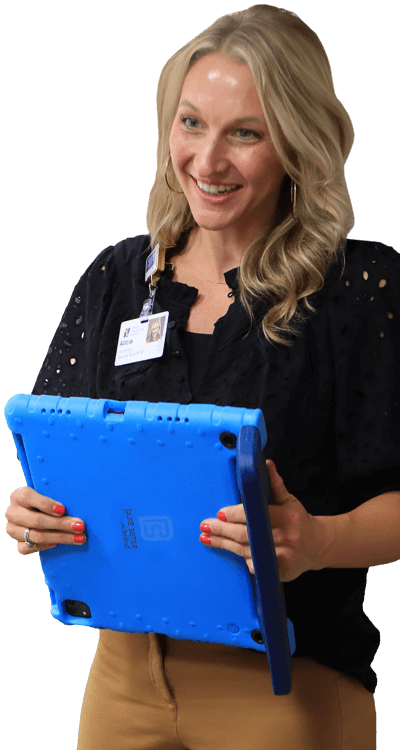If you’ve put off having surgery to get a new knee because of worries about the long, painful recovery process or having to use strong pain medications, a quad-sparing knee replacement might be right for you.
The innovative Jiffy Knee replacement approach to knee arthroplasty protects patients’ quadriceps, allowing them to start using their legs sooner after surgery and often requiring them to take fewer narcotics to manage pain during the recovery process.
Keep reading to learn how the Jiffy Knee procedure works and for details about who the approach benefits from Dr. Clayton Strong, a five-star-rated knee surgeon and one of Henry Community Health’s award-winning orthopedic providers. Plus, learn how this approach compares with other options for knee arthroplasty.
What is quad-sparing knee arthroplasty?
A quad sparing knee replacement uses a subvastus route to the joint. Rather than splitting the quadriceps tendon from the front (as is done with a traditional approach), the surgeon works under the vastus muscle to protect the extensor mechanism.
The quad-sparing family of techniques for knee replacement has been in clinical use for years. Jiffy Knee, one of the best-known methods, debuted in 2006. It’s now performed by a limited number of specially trained surgeons across the U.S.
Quadriceps-sparing knee replacement benefits
Here’s what patients typically notice with a quad-sparing knee replacement, especially in the first days after surgery:
Walk sooner
When the quadriceps tendon isn’t split, many patients can straighten the knee as the anesthetic wears off and begin therapy the same day, often about 90 minutes after surgery.
“By having quad function immediately after surgery, patients start therapy right away.”
Dr. Strong
Less pain
Muscle-sparing access generally makes the first phase of recovery more manageable. Dr. Strong is direct with expectations: “This is going to hurt, and you still have to do the therapy. What helps most is getting the quadriceps working right away and sticking with the plan.”
Faster return of strength
Because the extensor mechanism is protected, patients can actively use the quad instead of waiting weeks for a split tendon to heal. That jump-starts functional work in therapy.
Post-surgery pacing
Some Jiffy Knee patients feel so good after their knee replacement that they overexert themselves early in their recovery process, which can cause swelling.
Dr. Strong’s coaching is simple: “Do less and be consistent.”
Well-healed scar
“We’re meticulous with closure, using buried stitches and glue,” says Dr. Strong. “Also, placing the incision over muscle helps it heal nicely, and this also often helps it look better.”
Comparable long-term outcomes
Long-term results align with traditional approaches. Though the early phase of a patient’s recovery also tends to feel smoother when the quad is spared, ultimately “what matters most is that the surgeon correctly positions the components,” says Dr. Strong.
Is it “minimally invasive”?
Dr. Strong sums it up this way: “The Jiffy Knee technique is a minimally-traumatic, muscle-sparing approach” in which prosthesis implantation and soft-tissue handling differ from traditional knee replacement. That said, he avoids calling quad-sparing knee replacement “minimally invasive” because the incision length is similar to that used during traditional TKA surgery.
Who’s a good candidate for arthroplasty that avoids cutting the quadriceps tendon and muscles?
Quad-sparing methods are most effective when the knee can be safely exposed and balanced without splitting the tendon. They may not be suitable for individuals with very stiff knees, severe deformities, or complex revision cases where visibility and releases are more challenging to achieve.
Dr. Strong focuses on readiness and goals when it comes to guiding patients on knee replacements: “The perfect patient is someone who is miserable and has tried all non-operative treatments and not gotten relief, so they go in physically and emotionally prepared.”
Volume and experience matter. Ask surgeons how many total knee replacements they perform each year and about their rates of infection and revision.
“You want to choose a specialist who does 50–100 a year. With surgeons who do fewer, your risk of complications goes up.”
Dr. Strong
Not every arthroplasty surgeon offers a genuine quad-sparing knee replacement procedure. Jiffy Knee is a trademarked technique that requires one-on-one training with its originator. Surgeons may do a similar subvastus approach, but without that training, they can’t call it “Jiffy Knee.”
Other advanced knee replacement offerings
A quad sparing knee replacement isn’t your only modern option. Other newest knee replacement surgery options—such as robotic-assisted planning and implant placement, as well as smart-implant monitoring—may also benefit patients who need arthroplasty.
Henry Community Health prides itself on providing our patients with several advanced techniques and technologies for knee replacements. In addition to Jiffy Knee, we offer Stryker’s Mako SmartRobotics, Persona IQ’s “Smart Knee,” and cementless total knee replacement.
Call to set up a consultation with an HCH knee specialist to learn more about these options and learn which might be right for you.
FAQs about quad-sparing knee replacement surgery
Here are some answers to questions that patients often ask Dr. Strong before scheduling quad-sparing surgery for knee replacement.
How long does a jiffy knee replacement last?
“We expect each patient’s new knee to last 20–25 years. Some replacements last even longer,” says Dr. Strong. Failures with quad-sparing knee replacements, if and when they occur years down the road, are often based on whether surgeons use cement when placing implant components.
During Jiffy Knee replacement surgery, Dr. Strong considers health factors and bone quality when deciding whether to use a cemented or cementless implant.
Does Medicare cover quad-sparing knee replacement?
Yes! “It’s covered. Jiffy Knee has the same knee replacement code as the traditional approach,” says Dr. Strong. “There’s no difference.”

Can I get a quad-sparing knee replacement and go home the same day?
Often, yes. “If you’re healthy, your pain is controlled, and you have good help at home, patients go home the same day,” says Dr. Strong.
Note: If you’re an out-of-state patient, you’ll stay overnight so that Dr. Strong and his team can be sure there’s no clot risk before you travel home.
Where can I find a Jiffy Knee surgeon near me?
Dr. Strong is accepting new patients, both locally and from across the country. His team often provides care for patients from out-of-state.
If you live too far away and don’t want to travel, you can find a trained surgeon near you using the directory tool at the Jiffy Knee website.
How soon after a Jiffy Knee procedure can I start physical therapy?
With the Jiffy Knee quad-sparing approach, patients typically use their knees immediately, allowing them to begin therapy and rehabilitation almost immediately after surgery.
How risky is quadriceps-sparing knee arthroplasty?
The risks associated with the Jiffy Knee are the same as those with the traditional approach to replacement.
Those basic risks include “numbness around the incision (everyone experiences that), pain, stiffness, and potential implant failure and stiffness, pain,” says Dr. Strong. But, with a Jiffy Knee, “careful closure and incision placement over the muscle can help healing go faster and also improve how the scar looks.”
Another risk that comes with any surgery is anxiety, which is why it’s so important to Dr. Strong that his patients feel as confident as possible before their procedure.
“Anxiety is an emotion that produces pain, fear, and depression. So I try to help reduce each patient’s anxiety that can start before surgery because I know this can help them a lot.”
Dr. Strong
Choose Henry Community Health for quad-sparing knee replacement
HCH pairs advanced approaches—such as Jiffy Knee’s quad-sparing method—with careful, patient-specific preoperative planning and coordinated rehabilitation.
“Doctors shouldn’t behave like technicians,” says Dr. Strong. “We should act like teachers and set expectations up front.” Our patients receive clear guidance on managing their recovery and reducing swelling, along with straightforward information about work and activity timelines. Our patients receive clear guidance on pacing and swelling, along with straightforward information about work and activity timelines.
Ready to find out if a quad sparing knee replacement is right for you? Book a Jiffy Knee consultation with Dr. Strong.


